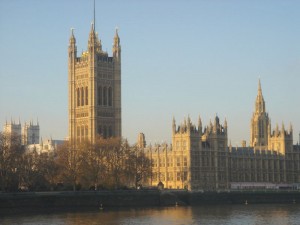 What will be the effect of raising tax allowances – the threshold at which people start paying income tax? The Coalition government in the UK has a policy of raising the threshold to £10,000 by 2015/16. As a step on this road, the present plan is to raise the threshold from £7475 in 2011/12 to £8105 in 2012/13. The Liberal Democrats, however, are urging the Chancellor to raise allowances more quickly.
What will be the effect of raising tax allowances – the threshold at which people start paying income tax? The Coalition government in the UK has a policy of raising the threshold to £10,000 by 2015/16. As a step on this road, the present plan is to raise the threshold from £7475 in 2011/12 to £8105 in 2012/13. The Liberal Democrats, however, are urging the Chancellor to raise allowances more quickly.
The government maintains that raising the personal allowance is progressive – that it will give relatively more help to the poor. New research by the Institute for Fiscal Studies, however, casts doubt on this claim. The IFS demonstrates that the benefits will be unevenly distributed, with the greatest benefits going to middle-income families where more than one person works but where no-one earns the higher tax rate. The poorest people – those earning below the threshold – will gain nothing at all.
Read the following articles and the IFS report and establish just who would benefit by a rise in the tax threshold and whether or not the move could be described at ‘progressive’.
Articles
Tax move ‘benefits better-off’ Independent, Joe Churcher (9/3/12)
Raising tax threshold would benefit rich more than poor, says IFS MyFinances.co.uk (11/3/12)
Rise in income tax threshold would help the rich Financial Times, Vanessa Houlder (9/3/12)
Budget 2012: raising the personal tax allowance threshold isn’t fair Guardian blog, Heather Stewart (9/3/12)
IFS report
A £10,000 personal allowance: who would benefit, and would it boost the economy? IFS, James Browne (March 2012)
Questions
- Define the term ‘progressive tax’.
- For what reasons might raising the personal tax allowance (a) be progressive; (b) not be progressive?
- How does eliminating child benefit for any families where either parent earns the higher tax rate affect the progressiveness of raising income tax thresholds?
- What additional measures could be taken to ensure that raising tax thresholds was progressive across the whole income range and for all households?
 For years, Britain has suffered a decline in its manufacturing base relative to many of its competitors. In part this was the result of the success of the financial sector and the accompanying high exchange rate. But, with the problems of the financial sector since 2007 and the subsequent recession, attention has increasingly turned to ways of stimulating manufacturing capacity and the competitiveness of the export sector generally.
For years, Britain has suffered a decline in its manufacturing base relative to many of its competitors. In part this was the result of the success of the financial sector and the accompanying high exchange rate. But, with the problems of the financial sector since 2007 and the subsequent recession, attention has increasingly turned to ways of stimulating manufacturing capacity and the competitiveness of the export sector generally.
In other words, attention has turned to the supply side of the economy.
But what should be the features of a successful supply-side policy? Should it encourage competition and focus largely on deregulation and removing ‘red tape’ to encourage market forces to operate more efficiently and effectively? Or should it be more interventionist?
The Business Secretary, Vince Cable, has been in the headlines for criticising his own government’s policy and arguing for a more active supply-side policy – one that is more interventionist. The following podcasts, the second of which is an interview with Dr Cable, look at the arguments for a more active supply-side policy and the forms it could take. The articles look at some of the arguments in more detail.
Podcasts
 Industrial strategy ‘lacking in the UK’ BBC Today Programme, Mariana Mazzucato (6/3/12)
Industrial strategy ‘lacking in the UK’ BBC Today Programme, Mariana Mazzucato (6/3/12)
 Government ‘getting behind’ industry BBC Today Programme, Vince Cable (6/3/12)
Government ‘getting behind’ industry BBC Today Programme, Vince Cable (6/3/12)
Articles
Cable urges long-term plan for industry Financial Times, George Parker (12/2/12)
Cable defends concern over lack of vision Financial Times, Elizabeth Rigby and George Parker (6/3/12)
Vince Cable leaked letter: in full The Telegraph (6/3/12)
Rusting Britain threatens recovery The Telegraph, Alexander Baldock (4/3/12)
Vince Cable is Right: we “lack a compelling vision of where the country is heading” Birmingham Post, David Bailey (6/3/12)
Rebuilding Britain’s economy: the hunt for an ‘industrial strategy’ Citywire Money, Chris Marshall (29/2/12)
Companies must stop hoarding cash and start investing instead Observer, Will Hutton (19/2/12)
Britain needs to shape an industrial strategy Observer, Editorial (4/3/12)
Questions
- Distinguish between the terms ‘industrial strategy’, ‘market-orientated supply-side policy’ and ‘interventionist supply-side policy’
- Identify some ways in which innovations and productivity growth can be supported by government.
- Does interventionist supply-side policy inevitably involve the government spending more?
- If the government wishes to encourage a more entrepreneurial country, should this involve a careful mix of intervention and market liberalisation and, if so, what should the mix look like?
- Summarise the arguments in Vince Cable’s letter to the Prime Minister and Deputy Prime Minister.
- What are the lessons of Silicon Valley for the UK and other European countries?
- How important is successful demand-side policy for a successful supply-side strategy?
- Comment on the following quote from the Will Hutton article above: “British companies are running a cash surplus of some 6% of GDP, again the largest in the world, but are refusing to spend that cash on investment or innovation, preferring to hoard it, preserve profit margins or buy back their own shares. Business investment as a share of GDP is thus the lowest among large industrialised countries.”
 Unemployment figures for the UK have been going in the wrong direction for some time. With consumer expenditure, investment and hence aggregate demand remaining low, job creation has been severely lacking. However, 2 pieces of news have emerged in the last couple of days, which as David Cameron said was ‘a massive confidence boost for the UK economy’. Tesco and Nissan have both announced the creation of thousands of new jobs.
Unemployment figures for the UK have been going in the wrong direction for some time. With consumer expenditure, investment and hence aggregate demand remaining low, job creation has been severely lacking. However, 2 pieces of news have emerged in the last couple of days, which as David Cameron said was ‘a massive confidence boost for the UK economy’. Tesco and Nissan have both announced the creation of thousands of new jobs.
Over the next 2 years, Tesco has said that it will create 20,000 new jobs through store improvement and the opening of new stores. Whilst it is not clear how many will be full-time, part-time or apprenticeship placements, it still represents net job creation. This huge investment represents what many are calling a ‘fight-back’ from Tesco, who issued its first profit warning in 20 years, following weak Christmas trading. That announcement slashed their shares by over £5bn and is perhaps partly responsible for this planned investment.
Despite this good news, criticisms have emerged that the major supermarkets are simply inflating the job creation figures and that the actual number of new jobs will be significantly less than the 20,000 suggested. This follows allegations made towards Asda, who claimed to have created 30,000 jobs. However, evidence from records at Companies House suggests that new job creation by the company was closer to 7,000. Whatever the true figure, it still means new jobs, which can only help UK unemployment data.
In addition to this, Nissan has also announced that it will be creating 2,000 new jobs, as it begins production on a new model at its Sunderland factory. The jobs will be created as part of a £125m investment, including a £9.3m grant from the government. This is especially good news, given the area where many of these jobs will emerge. The North East is a region that has been hit particularly hard by the recession and the grant from the government has come from its regional growth fund. Nissan has said that even in hard economic times, it is possible to sell cars, as long as they are competitively priced. Neither of the plans discussed above will create jobs immediately, but perhaps the key is that it creates confidence, which is a rarity in the UK with the current economic situation. The following articles consider these job creation plans and their wider implications.
Tesco plans to create 20,000 UK jobs over 2 years BBC News (5/3/12)
Tesco to create 20,000 jobs in UK fight-back Telegraph, Jamie Dunkley (6/3/12)
Tesco’s UK boss defends ‘new jobs’ claims Sky News (5/3/12)
Tesco to freshen up with 20,000 new staff Financial Times, Andrea Felsted (5/3/12)
Now Tesco creates 20,000 jobs – with pay Independent (9/5/11)
Nissan to build new car in Sunderland BBC News (6/3/12)
Nissan pledges 2,000 new jobs at North East plant Sky News, Gerard Tubb (6/3/12)
Nissan Invitation compact car set to create 2,000 jobs Telegraph, Roland Gribben and David Millward (6/3/12)
Nissan to create 2,000 new jobs by building compact car in Sunderland Guardian, Dan Milmo(6/3/12)
Questions
- Explain the process by which net job creation should provide a boost to the economy.
- Will these new jobs have any impact on the government’s budget deficit?
- Why is there concern that the supermarkets are inflating the employment creation figures?
- What type of unemployment has been created by the recession? Why have certain areas, such as the North East been affected so badly by the recession and austerity measures?
- Which factors could have led to Tesco’s weaker trading figures towards then end of 2011? Why did this lead to a £5bn loss in the value of the group’s shares?
- Nissan has said that cars can be sold as long as they are competitively priced. To what extent do you think price is the main competitive weapon in the market for cars and in the supermarket industry?
 In December 2011, the ECB provided some €489bn to banks in the form of three-year loans at low interest rates (1%) through open-market operations (see Will new ECB repo operations support the eurozone bond market?).
In December 2011, the ECB provided some €489bn to banks in the form of three-year loans at low interest rates (1%) through open-market operations (see Will new ECB repo operations support the eurozone bond market?).
These ‘Longer-term refinancing operations’ or ‘LTROs’ are designed to ease the burden on European banks which have been struggling to persuade markets that they are dealing with their large amounts of toxic debt, some of which is sovereign debt. Indeed, some of the ECB loans have been used to purchase Italian and Spanish bonds, thereby reducing the likelihood that these countries will default on their debts – at least for the timebeing.
On 29 February 2012, the ECB offered another round of LTROs. Some 800 banks borrowed €530bn under the scheme, bringing the total to a little over €1tr. Initially, much of the money has been put back on overnight deposit with the ECB. The hope, however, is that the loans will be used to support increased credit throughout the eurozone and to fund further purchases of sovereign debt.
But will the increased narrow money supply in the eurozone through these open-market operations result in increased broad money and increased spending and growth? The answer to that depends a great deal on confidence: confidence of banks to lend to firms and consumers; confidence of firms and consumers to borrow. The hope is that the extra money supply will not simply see a corresponding reduction in the velocity of circulation.
The following articles consider the likely effects of these longer-term repos on the real economy.
Articles
ECB hands €529bn in emergency loans to European banks Guardian, Heather Stewart (29/2/12)
Q&A: The ECB’s bank funding programme The Telegraph, Angela Monaghan (29/2/12)
Fighting Debt with Debt Forbes, Bob McTeer (5/3/12)
Is ECB’s €1trn cash boost just the tip of the iceberg? Investment Week, Kyle Caldwell, Dan Jones (5/3/12)
Banks deposit record €821bn at ECB Financial Times, Mary Watkins (5/3/12)
Europe economy may see slim gain from supersize funding: poll Reuters, Sumanta Dey (5/3/12)
Who is the ECB helping? BBC News, Stephanie Flanders (29/2/12)
ECB information on OMOs
Open Market Operations ECB
Questions
- Explain how longer-term refinancing operations work.
- What will determine how much of these ECB loans will be lent to companies?
- Explain what is meant by (a) the velocity of circulation; (b) the money multiplier. Why will the size of these two determine the likely success of the ECB’s LTRO programme?
- Why may the ECB’s actions boost market sentiment? Why might they have the opposite effect?
- Explain what is meant by the “continued de-leveraging by banks”. How does this impact on the money multiplier?
 A negative outlook for the UK economy – at least that’s what Moody’s believes. The credit rating agency has put the UK economy’s sovereign credit rating, together with 2 other European nations (France and Austria) on the ‘negative outlook’ list.
A negative outlook for the UK economy – at least that’s what Moody’s believes. The credit rating agency has put the UK economy’s sovereign credit rating, together with 2 other European nations (France and Austria) on the ‘negative outlook’ list.
The UK currently has a triple A rating and we have been able to maintain this despite the credit crunch and subsequent recession. However, with weak economic data and the continuing crisis in the eurozone, Moody’s took the decision to give the UK a ‘negative outlook’, which means the UK, as well as France and Austria have about a 30% chance of losing their triple A rating in the next 18 months.
Both Labour and the Coalition government have claimed this decision supports their view of the economy. Labour says this decision shows that the economy needs a stimulus and the Coalition should change its stance on cutting the budget deficit. However, the Coalition says that it shows the importance the Credit ratings agencies attach to budget deficits. Indeed, Moody’s statement showed no signs that it feels the UK should ease up on its austerity measures. The statement suggested the reverse – that a downgrade would only occur if the outlook worsened or if the government eased up on its cuts. The Coalition’s focus on cutting the deficit could even be something that has prevented the UK being put on the ‘negative watch’ list, as opposed to the ‘negative outlook’ list. The former is definitely worse than the latter, as it implies a 50% chance of a downgrade, rather than the current 30%.
The triple A rating doesn’t guarantee market confidence, but it does help keep the cost of borrowing for the government low. Indeed, the UK government’s cost of borrowing is at an historic low. A key problem therefore for the government is that there is a certain trade-off that it faces. Moody’s says that 2 things would make the UK lose its rating – a worsening economic outlook or if the government eases on its austerity plans. However, many would argue that it is the austerity plans that are creating the bad economic outlook. If the cuts stop, the economy may respond positively, but the deficit would worsen, potentially leading to a downgrade. On the other hand, if the austerity plans continue and the economy fails to improve, a downgrade could also occur. The next few days will be crucial in determining how the markets react to this news. The following articles consider this issue.
The meaning of ‘negative’ for Mr Osborne and the UK BBC News, Stephanomics, Stephanie Flanders (14/2/12)
Relaxed markets remain one step ahead of Moody’s move The Telegraph, Philip Aldrick (14/2/12)
George Osborne tries to be positive on negative outlook for economy Guardian, Patrick Wintour (14/2/12)
Moody’s wants it may cut AAA-rating for UK and France Reuters, Rodrigo Campos and Walter Brandimarte (14/2/12)
Moody’s rating decision backs the Coalition’s path of fiscal consolidation The Telegraph, Damian Reece (14/2/12)
Moody’s rating agency places UK on negative outlook BBC News (14/2/12)
Britain defends austerity measures New York Times, Julia Werdigier 14/2/12)
Questions
- What does a triple A rating mean for the UK economy?
- Which factors will be considered when a ratings agency decides to change a country’s credit rating? What similarities exist between the UK, France and Austria?
- Which political view point do you think Moody’s decision backs? Do you agree with the Telegraph article that ‘Moody’s rating decision backs the Coalition’s path of fiscal consolidation’?
- If a country does see its credit rating downgraded, what might this mean for government borrowing costs? Explain why this might cause further problems for a country?
- How do you think markets will react to this news? Explain your answer.
- What action should the government take: continue to cut the deficit or focus on the economic outlook?
- Why has the eurozone crisis affected the UK’s credit rating?
 What will be the effect of raising tax allowances – the threshold at which people start paying income tax? The Coalition government in the UK has a policy of raising the threshold to £10,000 by 2015/16. As a step on this road, the present plan is to raise the threshold from £7475 in 2011/12 to £8105 in 2012/13. The Liberal Democrats, however, are urging the Chancellor to raise allowances more quickly.
What will be the effect of raising tax allowances – the threshold at which people start paying income tax? The Coalition government in the UK has a policy of raising the threshold to £10,000 by 2015/16. As a step on this road, the present plan is to raise the threshold from £7475 in 2011/12 to £8105 in 2012/13. The Liberal Democrats, however, are urging the Chancellor to raise allowances more quickly.



